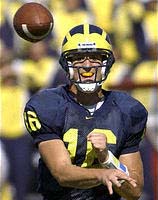When the football travels through the air
(long pass, punt, kickoff,
field goal), it always follows a curved, or
parabolic, path because
the movement of the ball in the vertical
direction is influenced by
the force of gravity As the ball travels up,
gravity slows it down until
it stops briefly at its peak height, the ball
then comes down, and
gravity accelerates it until it hits the ground. This
is the path of any
object that is launched or thrown and is called
projectile motion.
A good example of projectile motion in football is
the punt. When a
punter kicks a football, he can control three factors:
- the velocity or
speed at which the ball leaves his foot
- the angle of the
kick
- the rotation of
the football
The rotation of the ball (spiral) will
influence how the ball slows down in flight, because the ball is affected
by air drag. A spiraling kick will have less air drag, will not slow down
as much, and will be able to stay in the air longer and go farther than an
end-over-end kick. The velocity of the ball and the angle of the kick are
the major factors that determine:
- how long the ball
will remain in the air (hang-time)
- how high the ball
will go
- how far the ball
will go
NEXT |
